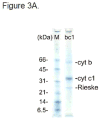Tyrosine triad at the interface between the Rieske iron-sulfur protein, cytochrome c1 and cytochrome c2 in the bc1 complex of Rhodobacter capsulatus
- PMID: 22306765
- PMCID: PMC3322269
- DOI: 10.1016/j.bbabio.2012.01.013
Tyrosine triad at the interface between the Rieske iron-sulfur protein, cytochrome c1 and cytochrome c2 in the bc1 complex of Rhodobacter capsulatus
Abstract
A triad of tyrosine residues (Y152-154) in the cytochrome c(1) subunit (C1) of the Rhodobacter capsulatus cytochrome bc(1) complex (BC1) is ideally positioned to interact with cytochrome c(2) (C2). Mutational analysis of these three tyrosines showed that, of the three, Y154 is the most important, since its mutation to alanine resulted in significantly reduced levels, destabilization, and inactivation of BC1. A second-site revertant of this mutant that regained photosynthetic capacity was found to have acquired two further mutations-A181T and A200V. The Y152Q mutation did not change the spectral or electrochemical properties of C1, and showed wild-type enzymatic C2 reduction rates, indicating that this mutation did not introduce major structural changes in C1 nor affect overall activity. Mutations Y153Q and Y153A, on the other hand, clearly affect the redox properties of C1 (e.g. by lowering the midpoint potential as much as 117 mV in Y153Q) and the activity by 90% and 50%, respectively. A more conservative Y153F mutant on the other hand, behaves similarly to wild-type. This underscores the importance of an aromatic residue at position Y153, presumably to maintain close packing with P184, which modeling indicates is likely to stabilize the sixth heme ligand conformation.
Copyright © 2012 Elsevier B.V. All rights reserved.
Figures










Similar articles
-
Plasmon waveguide resonance spectroscopic evidence for differential binding of oxidized and reduced Rhodobacter capsulatus cytochrome c2 to the cytochrome bc1 complex mediated by the conformation of the Rieske iron-sulfur protein.Biochemistry. 2007 Jun 19;46(24):7138-45. doi: 10.1021/bi602649u. Epub 2007 May 22. Biochemistry. 2007. PMID: 17516628 Free PMC article.
-
Functional flexibility of electron flow between quinol oxidation Qo site of cytochrome bc1 and cytochrome c revealed by combinatory effects of mutations in cytochrome b, iron-sulfur protein and cytochrome c1.Biochim Biophys Acta Bioenerg. 2018 Sep;1859(9):754-761. doi: 10.1016/j.bbabio.2018.04.010. Epub 2018 Apr 27. Biochim Biophys Acta Bioenerg. 2018. PMID: 29705394
-
Interactions between the cytochrome b, cytochrome c1, and Fe-S protein subunits at the ubihydroquinone oxidation site of the bc1 complex of Rhodobacter capsulatus.Biochemistry. 1998 Jun 2;37(22):8105-14. doi: 10.1021/bi973146s. Biochemistry. 1998. PMID: 9609705
-
The bc1 complexes of Rhodobacter sphaeroides and Rhodobacter capsulatus.J Bioenerg Biomembr. 1993 Jun;25(3):195-209. doi: 10.1007/BF00762582. J Bioenerg Biomembr. 1993. PMID: 8394316 Review.
-
Design and use of photoactive ruthenium complexes to study electron transfer within cytochrome bc1 and from cytochrome bc1 to cytochrome c.Biochim Biophys Acta. 2013 Nov-Dec;1827(11-12):1309-19. doi: 10.1016/j.bbabio.2012.09.002. Epub 2012 Sep 15. Biochim Biophys Acta. 2013. PMID: 22985600 Free PMC article. Review.
Cited by
-
Binding Site Recognition and Docking Dynamics of a Single Electron Transport Protein: Cytochrome c2.J Am Chem Soc. 2016 Sep 21;138(37):12077-89. doi: 10.1021/jacs.6b01193. Epub 2016 Sep 7. J Am Chem Soc. 2016. PMID: 27508459 Free PMC article.
References
-
- Yeates CL, Batchelor JF, Capon EC, Cheesman NJ, Fry M, Hudson AT, Pudney M, Trimming H, Woolven J, Bueno JM, Chicarro J, Fernandez E, Fiandor JM, Gargallo-Viola D, Gomez de las Heras F, Herreros E, Leon ML. Synthesis and Structure–Activity Relationships of 4-Pyridones as Potential Antimalarials. J Med Chem. 2008;51:2845–2852. - PubMed
-
- Barlett DW, Clough JM, Godwin JR, Hall AA, Hamer M, Parr-Dobrzanski B. The strobilurin fungicides. Pest Manag Sci. 2002;58:649–662. - PubMed
-
- Jordan DB, Kranis KT, Picollelli MA, Schwartz RS, Sternberg JA, Sun KM. Famoxadone and oxazolidinones: potent inhibitors of cytochrome bc1. Biochem Soc Trans. 1999;27:577–580. - PubMed
Publication types
MeSH terms
Substances
Grants and funding
LinkOut - more resources
Full Text Sources
Miscellaneous

